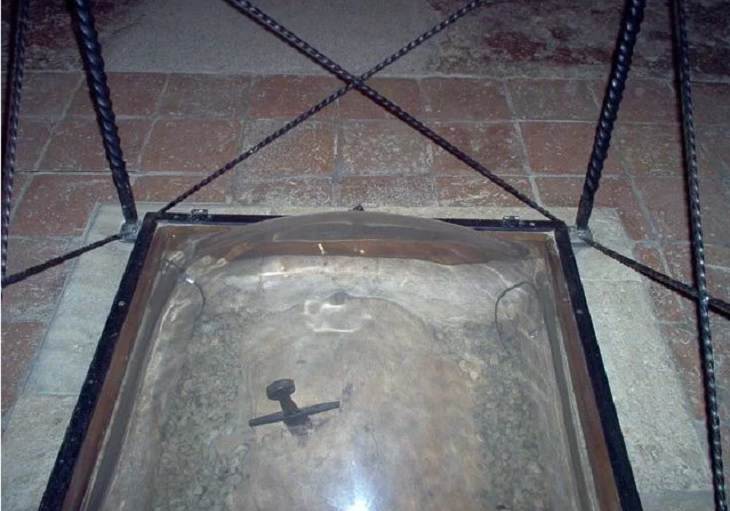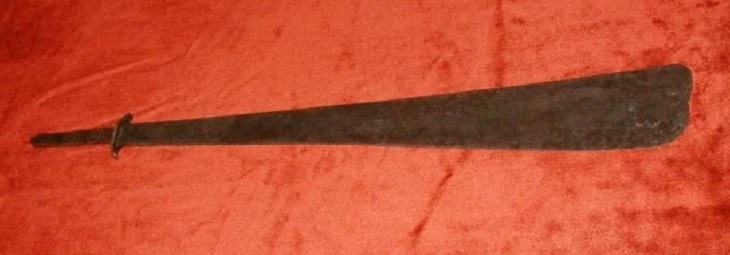1. The Sword in the Stone
Few people haven't heard about the British legend of King Arthur and the sword in the stone. While this is nothing more than legend, what many people don't know is that Italy has its own version of the Excalibur legend. This sword belonged to St Galgano Guidotti, a 12th-century Tuscan knight, and was known for being one of the most remarkable relics of the Middle Ages. According to popular belief, Galgano Guidotti plunged the sword into the stone. It all began after the Archangel Michael ordered the knight to give up his sinful habits. At first, Guidotti objected, saying it would be much easier for him to cut a stone with his sword than to renounce his sinful habits. Legend has it that his blade passed easily through the stone where it remains stuck to date. The miracle is said to have made Guidotti devote the rest of his life to God.
2. The Kusanagi
A Japanese legend has it that this mysterious sword was found in the body of a legendary eight-headed serpent that was killed by the Shinto god of sea and storms, Susano. A number of legends concerning the great powers of Kusanagi have been told and retold throughout the centuries in Japan, including the one about how Yamato Takeru defeated his enemies by using the sword's power to control the wind. According to legend, the sword continued growing over the years, but according to some accounts, the sword was lost forever after the 12th century Battle of Dan-no-Ura. No one knows for sure whether or not the modern Kusanagi, housed in the Atsuta Shrine is the original one, however. In fact, no one has ever seen the sword, not even the current Emperor of Japan. And while its existence continues to be a matter of debate, what remains indisputable is the fact that Kusanagi is an integral part of Japanese culture, history, and mythology and will remain so for centuries to come.
3. Durandal

According to legend, out of the 12 legendary paladins in service of King Charlemagne, Roland was the most courageous. The medieval legends surrounding his name involve one more thing - Durandal, the sword of Roland. As in other sword legends, the origin of Durandal has been shrouded in mystery over the centuries. Perhaps, the best-known version of the legend is the one that states the sword belonged to the Trojan hero Hector and was given to the paladin Roland by an enchanter, Maugris. In another version of the legend, a mythical smith, known as Wayland the Smith forged Durandal, and it is said that the sword had been taken by an angel and brought to Charlemagne, who gave it to Roland. It is said that with the help of Durandal, Roland went on to win many battles before he was defeated at the Battle of Roncevaux. Conferring to legend, in an attempt to destroy Durandal after the defeat, the mighty Roland created La Brèche de Roland, a 130-foot natural gap, high up in the Pyrenees.
4. The Cursed Muramasa
The Muramasa Sengo is said to be one of the greatest swordsmiths in Ancient Japan, creating blades of great beauty and strength. According to legend, it was not enough and the greatest swordsmith prayed to the gods that his swords would become the prodigious destroyers. The gods granted Muramasa what he requested and his swords became extremely dangerous, for both enemies and the wielders. The legend tells of a dark curse that caused the swords to turn on their owners if they were not satisfied with combat and there was nothing the wielder could do to prevent it. The sword had an excessive sharpness that became a symbol of Japanese sword-making skills.
5. St. Peter’s Sword
This is another mysterious sword that is believed to have been in the possession of St Peter. As you may have guessed, there is more than one legend concerning the sword involved in the incident of Peter cutting off the right ear of Malchus, the servant of the Jewish High Priest Caiaphas, during Jesus' arrest in the Garden of Gethsemane. It is also believed that the sword resided in Rome for several centuries before it was brought to Poland after the country had adopted Christianity as a state religion. The sword can be seen at the Archdiocese Museum in Poznan, Poland. It was used as a ceremonial sword during the coronation of numerous Polish monarchs.
6. The Wallace Sword
This sword is proudly displayed in the National Wallace Monument in Stirling. It is believed to have been used by William Wallace, one of Scotland's greatest historical figures. While there is no clear evidence that the sword actually belonged to the legendary Scottish knight, its importance as a symbol of freedom and as one of Scotland's most treasured national icons cannot be disputed.






